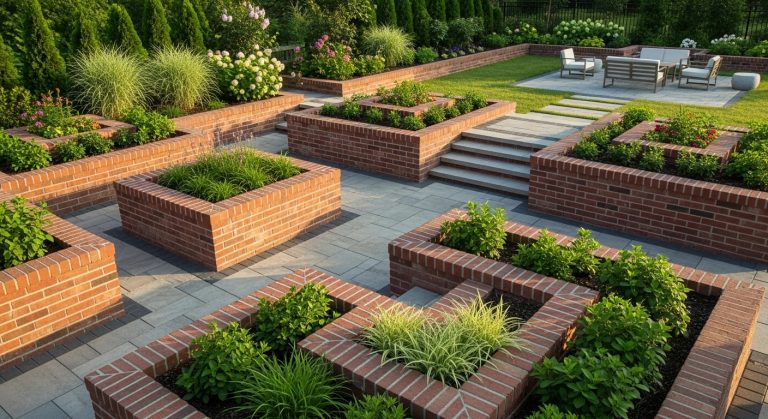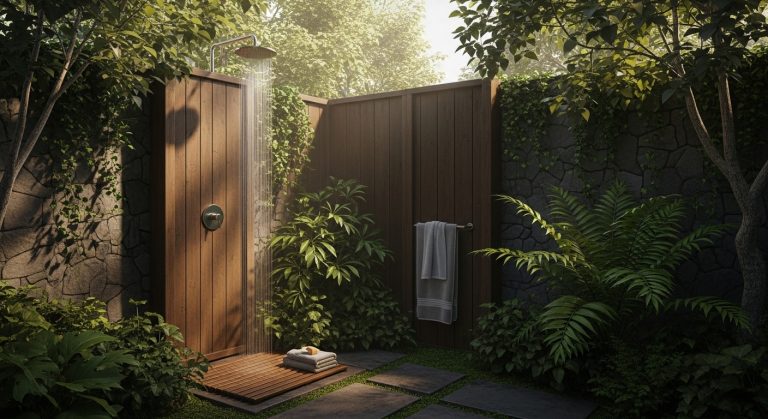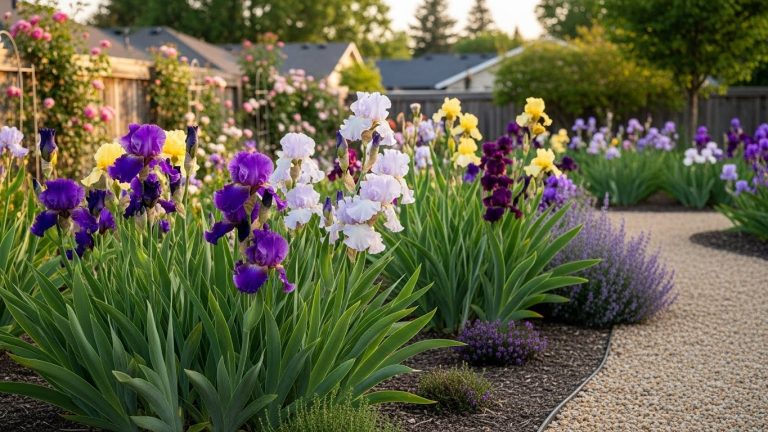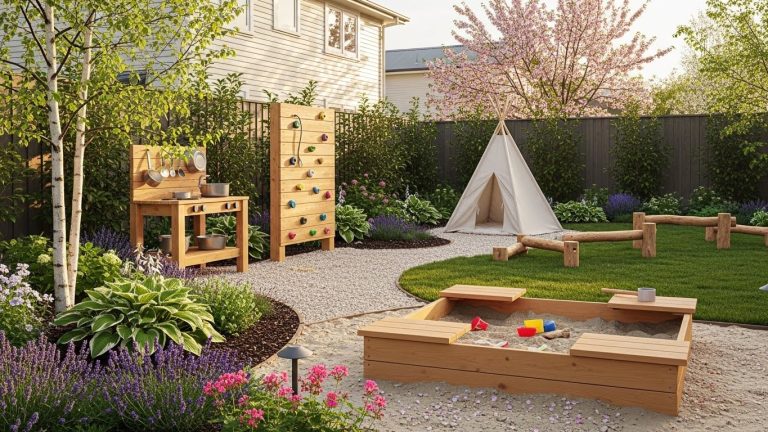Garden Rake Ideas: 15 Clever Ways to Transform Your Yard With One Simple Tool
I’ll be honest with you — a garden rake might seem like the most unexciting tool in the shed. It’s always the thing leaning awkwardly against the wall, waiting for fall leaves or a chore no one else wants. But here’s the plot twist: I’ve learned over the years that a rake is secretly one of the smartest, most versatile tools you can use in your yard. And yes, I’ve had entire Saturdays saved simply because I reached for a rake instead of lugging out the heavy-duty gear.
Ever noticed how one simple tool sometimes changes everything? That’s exactly why garden rake ideas are trending like crazy across gardening forums and DIY groups. People are discovering new ways to use their rake for landscaping, organizing, decorating, leveling, clearing, and even crafting. Honestly, it’s wild how creative gardeners can get when we’re tired of buying expensive equipment and just want one trusty tool that does it all.
What I’m sharing with you here isn’t just theory. These are real, practical, and clever ideas I’ve picked up through experience, neighbors, gardening friends, and yes, a few YouTube rabbit holes. Each one shows you how to get more out of your rake — whether you’re organizing soil, shaping edges, or even turning broken handles into rustic garden décor.
Alright, let’s jump into the good stuff. Here are 15 garden rake ideas that actually make your yard work easier, cleaner, and a whole lot more satisfying.
1. Using Your Garden Rake to Level Fresh Soil Beds

Have you ever tried planting in a bed that wasn’t level? It’s like trying to pour water on a table with one leg missing — everything rolls to the weirdest corner. That’s where your humble rake steps in. Leveling soil with a rake is simple but surprisingly effective, especially when prepping new gardening spaces.
Pros
- Easy to control the surface height without needing bulky machinery.
- Perfect for small to medium gardens, where precision matters more than speed.
- Saves money, since you don’t need to rent a roller, tiller, or landscape rake.
- Helps create a uniform base, which improves water distribution and root depth.
Cons
- Takes time if you’re working with large terrain.
- Requires multiple passes to get a truly even surface.
Takeaway
A rake is honestly the ideal tool for flattening small patches. Level first, plant second — your garden will thank you.
2. Creating Crisp, Defined Pathways With Simple Raking Patterns
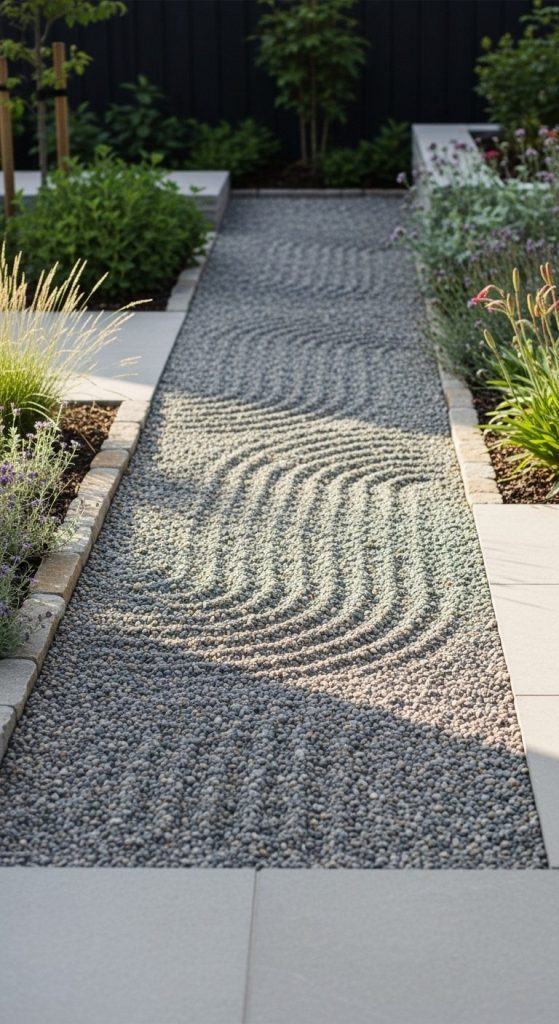
There’s something visually satisfying about a clean garden path — almost like the yard equivalent of a fresh haircut. What most people don’t realize is that you can get that crisp, raked-gravel look without fancy tools. Your garden rake can carve out subtle textures that make your pathways look intentional instead of “accidental footpath through the mud.”
Pros
- Adds instant structure to your garden design.
- Improves traction, especially on gravel or mulch paths.
- Let’s you customize patterns like waves, straight lines, or cross-hatching.
- Quick to refresh, even weekly.
Cons
- Patterns fade quickly after rain or heavy foot traffic.
- Not ideal for extremely fine gravel, which may not hold texture.
Takeaway
If you love low-effort, high-impact design, raked pathways give your yard a clean, almost Japanese-garden feel with almost no cost.
3. Using Your Rake to Spread Mulch More Evenly

There’s a huge difference between a mulched garden bed and a properly mulched garden bed. Even coverage helps retain moisture, block weeds, and improve soil temperature. A rake is perfect for pulling mulch into corners, flattening high piles, and keeping things neat.
Pros
- Distributes bulky mulch easily, saving back strain.
- Prevents mulch mountains that smother plants.
- Creates a polished, finished look instantly.
- Lets you measure depth as you go—most experts recommend 2–3 inches.
Cons
- Wet mulch can clump, making raking harder.
- Not ideal for rubber mulch, which tends to bounce or snag.
Takeaway
Mulch is magic for gardens, and your rake makes spreading it cleaner, simpler, and a whole lot faster.
4. Using a Rake to Clear Thatch and Restore Your Lawn
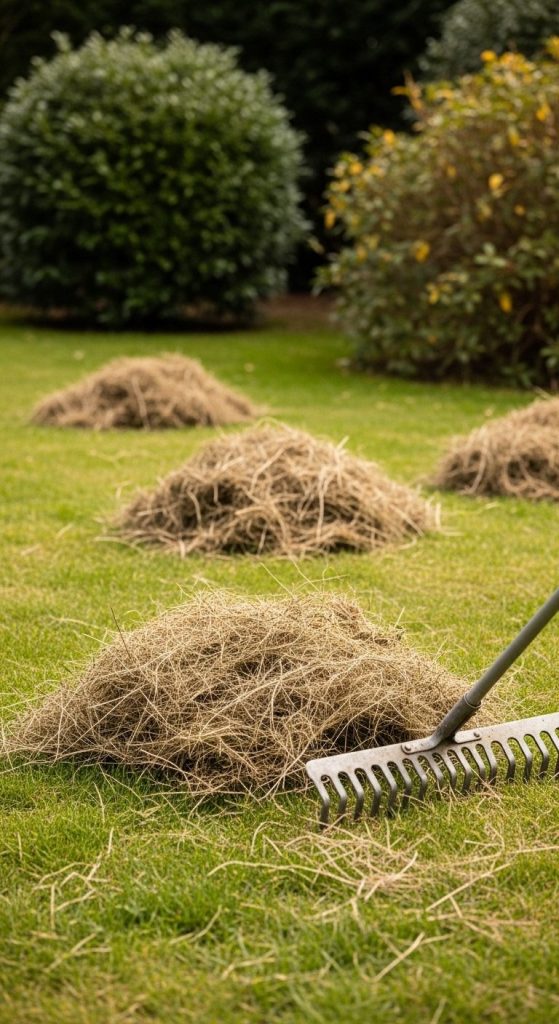
If your lawn looks dull, patchy, or weirdly spongey, you may be dealing with thatch buildup. A rake (especially a dethatching rake) pulls up all that dead material hiding below the surface. And trust me, the before-and-after difference is huge.
Pros
- Improves airflow at the soil level, helping new growth.
- Helps water reach roots, increasing absorption.
- Encourages greener, healthier grass within weeks.
- Avoids costly power dethatchers, especially for small yards.
Cons
- Labor-intensive, especially with thick thatch.
- May need repeated passes depending on severity.
Takeaway
If your lawn feels suffocated, a rake-based dethatching session might be the revival trick you’ve been looking for.
5. Grooming Gravel Driveways With a Heavy-Duty Rake
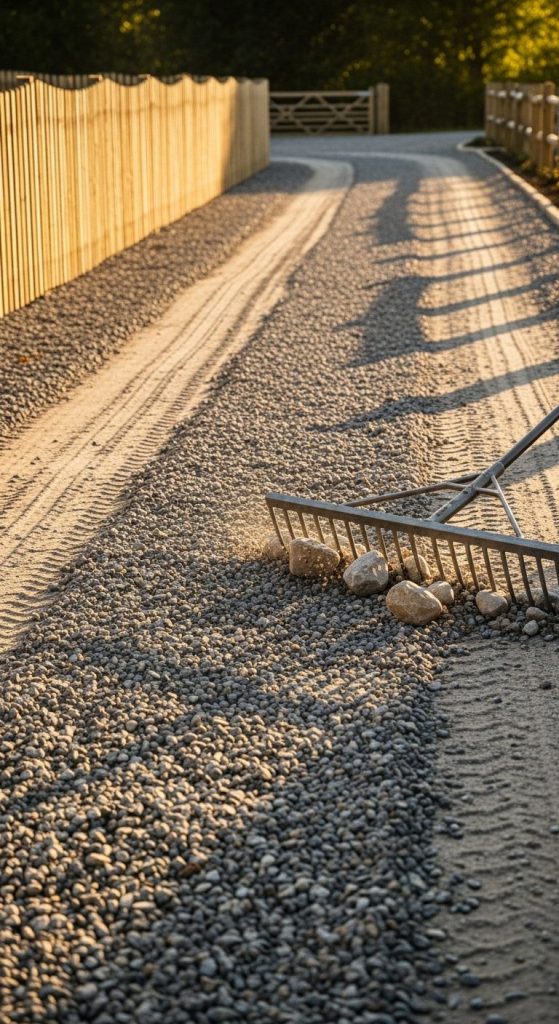
Gravel driveways are beautiful until the first rainstorm pushes every little stone to the side. A heavy-duty rake helps you pull displaced gravel back into place, smooth high spots, and fill low dips.
Pros
- Extends driveway lifespan by redistributing stones.
- Fixes tire ruts and uneven spots in minutes.
- Saves money on buying replacement gravel.
- Works well after storms, when the surface shifts most.
Cons
- Large driveways take time to groom manually.
- Not effective on deeply eroded areas, which may require new gravel.
Takeaway
A few minutes of raking every week keeps gravel driveways tidy, safe, and surprisingly elegant.
6. Using a Rake to Break Up Soil Clumps for Planting
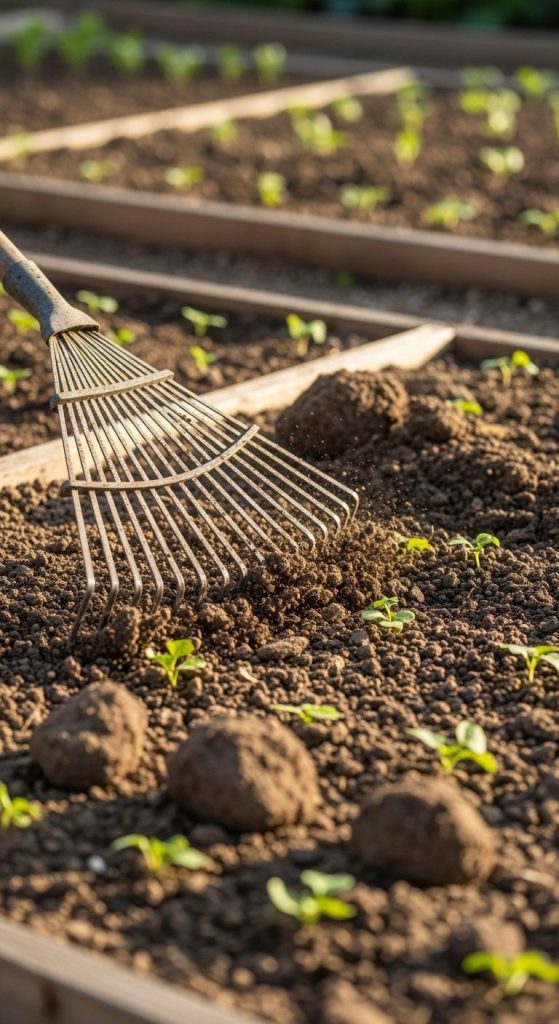
Ever tried planting in clumpy soil? It’s like digging through miniature concrete chunks. A rake breaks those clumps apart, giving your seedlings a softer, more breathable home.
Pros
- Improves soil aeration, which boosts root growth.
- Helps fertilizers mix evenly into the top layer.
- Prepares garden beds quickly after tilling.
- Supports better moisture retention in broken-up soil.
Cons
- Heavy clay soil still needs extra effort.
- May require extra passes for large clods.
Takeaway
Breaking soil with a rake is simple, effective, and way easier on your back than bending over with hand tools.
7. Turning Old Rakes Into Rustic Wall Hooks
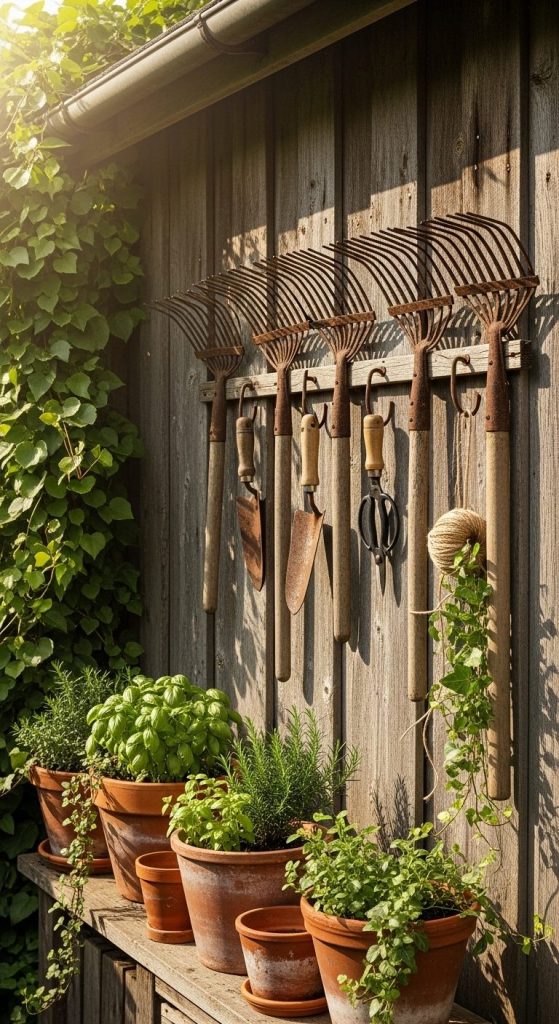
If you’ve ever seen those Pinterest-style garden sheds with cute hanging tools, this is the secret. Old metal rake heads make perfect rustic hooks once you remove the handle and mount them on a wall.
Pros
- Great upcycling project, eco-friendly and unique.
- Strong enough to hold heavy tools.
- Adds charm to sheds, patios, and even kitchens.
- Costs nothing if your rake is already old or broken.
Cons
- Requires drilling for mounting.
- Metal tines may be sharp, so you may need to sand them.
Takeaway
Before you toss that old rake, turn it into storage — it’s surprisingly stylish and functional.
8. Using a Rake to Create Garden Furrows for Seed Planting
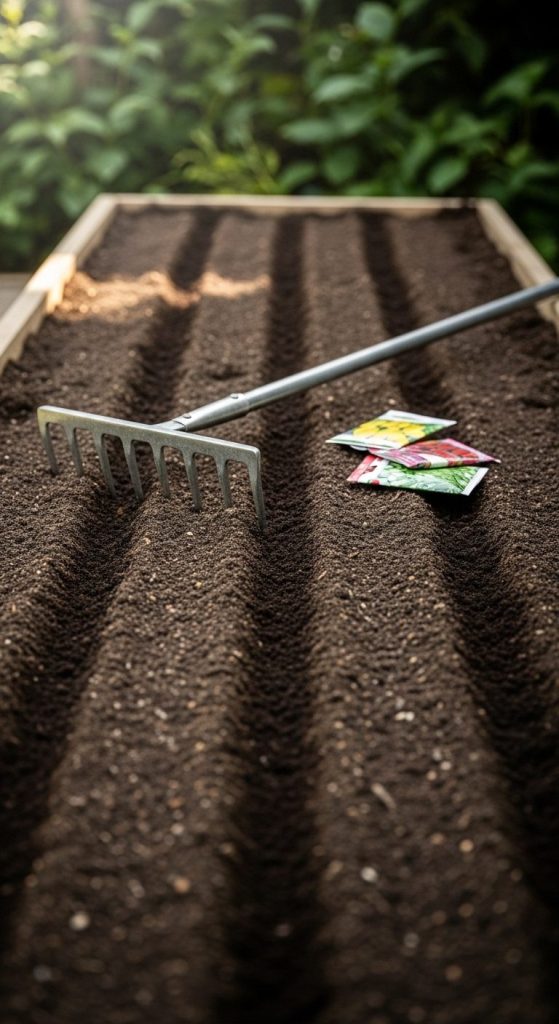
Whether you’re planting veggies or annual flowers, furrows help control spacing and water flow. A rake makes perfectly straight, consistent rows.
Pros
- Keeps rows even, making gardens easier to manage.
- Improves irrigation, especially with drip lines.
- Perfect for raised beds, where space is limited.
- Works for both large and small seeds, depending on tine depth.
Cons
- Requires steady hand, or rows can go crooked.
- Not ideal for very hard soil, which may need pre-watering.
Takeaway
If you love tidy garden rows, a rake might be your new best friend during planting season.
9. Smoothing Sand or Soil in Children’s Play Areas

If you have kids, you know how fast a sandbox turns from “cute little play area” to “miniature lunar crater.” A rake quickly smooths and refreshes the surface.
Pros
- Restores playability in seconds.
- Removes debris, like leaves or toys hiding underneath.
- Creates a flat, safe surface, especially for toddlers.
- Works for both sand and soft soil, depending on rake type.
Cons
- Needs frequent upkeep, depending on usage.
- Light plastic rakes may struggle with compacted sand.
Takeaway
A quick rake pass keeps play areas neat, comfortable, and kid-friendly.
10. Grooming Pebble or Zen Gardens With Fine-Tine Rakes

Zen gardens rely heavily on the look of carefully raked patterns — simple lines that feel calming to look at. A small fine-tine rake (or even a mini desk rake) lets you redesign the surface anytime you want a fresh look.
Pros
- Adds tranquility to your outdoor space.
- Perfect for stress relief, since pattern-making is soothing.
- Allows infinite designs, from circles to flowing waves.
- Enhances the aesthetic, giving your yard a high-end feel.
Cons
- Patterns vanish quickly after wind or rain.
- Requires regular attention, especially if used decoratively.
Takeaway
If you want a soothing, meditative hobby, raking a Zen garden offers quiet moments of creativity.
11. Using a Rake to Collect Fallen Fruit Under Fruit Trees
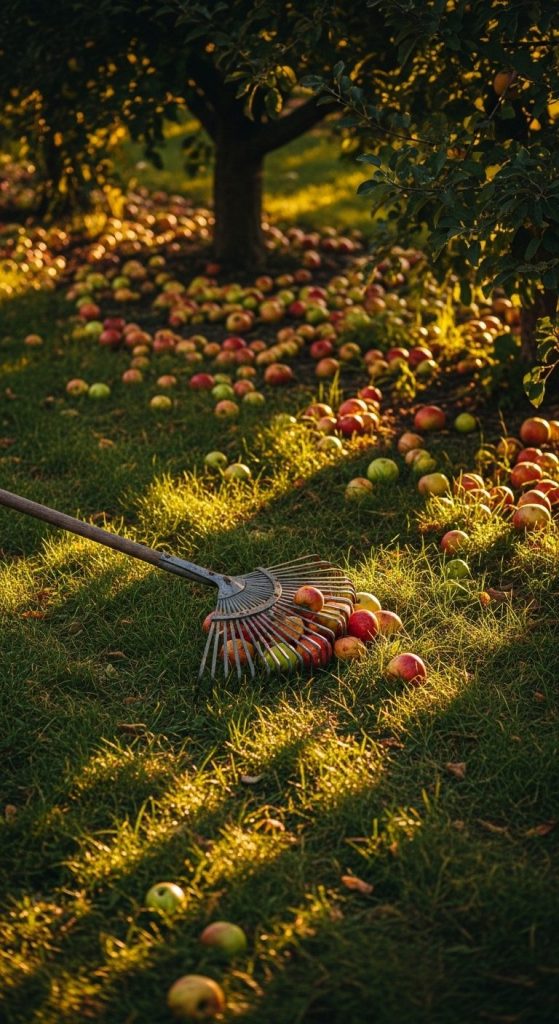
If you’ve ever stepped barefoot on a rotting plum or apple, you already understand why this matters. A rake helps gather fallen fruit quickly, keeping pests away and reducing waste.
Pros
- Prevents pests, especially wasps and fruit flies.
- Keeps the area clean, reducing rot and mold.
- Saves time, especially when fruit drops heavily.
- Let’s you sort usable fruit more easily.
Cons
- Soft fruit may smear, requiring extra cleanup.
- Rake tines can damage fresh fruit, if you’re trying to save it.
Takeaway
A rake keeps fruit trees tidy — and your shoes much safer.
12. Clearing Pine Needles Without Clogging Your Tools

Traditional leaf rakes struggle with pine needles. But a sturdy, flexible metal rake handles them beautifully. If you’ve ever lived near pine trees, you know what a game changer this is.
Pros
- Collects needles quickly, even when layered.
- Reduces fire hazards, especially in dry climates.
- Keeps gutters and pathways clear.
- Better than leaf blowers, which scatter needles everywhere.
Cons
- Needles tangle easily, requiring frequent shaking.
- Some areas, like rocky beds, still need hand cleanup.
Takeaway
For pine-heavy yards, the right rake saves hours and keeps your landscape safer.
13. Using a Rake to Spread Compost Efficiently

Compost is rich but dense. If you dump it onto a bed and leave it, you’ll get a big, chunky mess. But a rake helps distribute it into a smooth, workable layer that plants can thrive in.
Pros
- Breaks compost chunks, improving soil absorption.
- Creates an even layer, preventing nutrient overload.
- Mixes compost and soil, giving roots better access.
- Great for organic gardening, per expert recommendations (source: University of Vermont Extension).
Cons
- Very wet compost can stick to rake tines.
- Requires patience, especially with thick mulch mixes.
Takeaway
If you’re serious about soil health, raking compost is one of the easiest upgrades you can make.
14. Raking Leaves Into Clean, Manageable Piles

Classic? Yes. But still a genius use. Leaf blowers might be loud, annoying, and overkill. Rakes create tidy piles without waking the neighbors or scaring pets.
Pros
- Quiet and eco-friendly, especially compared to blowers.
- Great exercise, burning up to 200–300 calories per hour (source: Harvard Health).
- Lets you compost leaves, turning them into garden gold.
- Ideal for lawns, preventing suffocation of grass.
Cons
- Time-consuming in large yards.
- Windy days can undo everything fast.
Takeaway
Leaf raking is old-school, but it’s efficient, peaceful, and compost-friendly.
15. Turning a Rake Into DIY Garden Art or Sculptural Décor
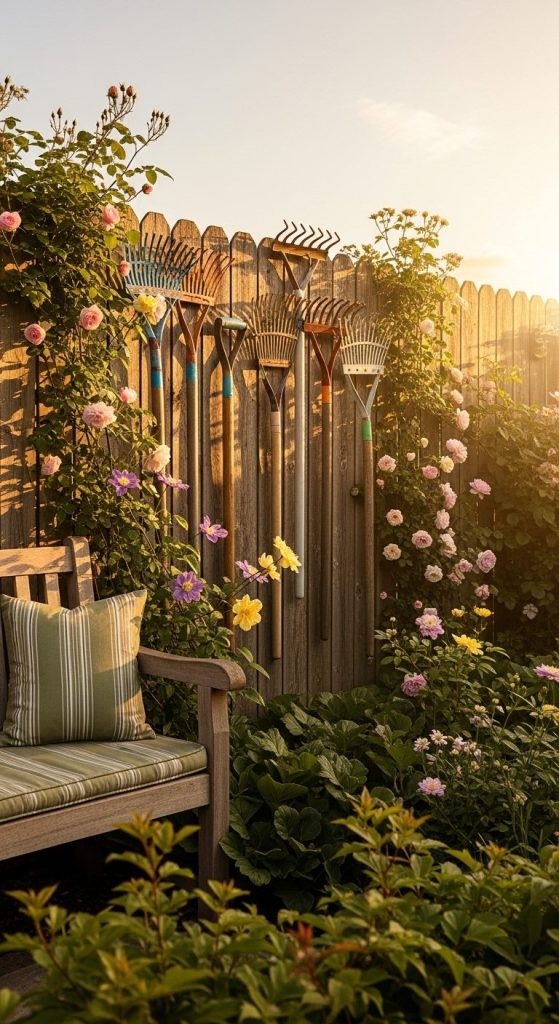
This is where your creative side gets to shine. Old rakes can be painted, repurposed, or turned into quirky garden art. Some folks even use them to hang string lights — which honestly looks adorable.
Pros
- Endless design options, from rustic to whimsical.
- Upcycles broken rakes, reducing waste.
- Adds personality to garden corners or seating areas.
- Costs almost nothing, making it perfect for budget decorators.
Cons
- Metal rakes rust, unless treated.
- Decor pieces need sealing, or weather will age them quickly.
Takeaway
Your yard deserves charm — and an old rake makes surprisingly cute décor.
Conclusion
It’s funny how we often overlook the simplest tools. The humble garden rake might never feel glamorous, but it consistently shows up to support your yard, your projects, and your creativity. Whether you’re shaping soil, clearing paths, distributing compost, or crafting rustic wall décor, the rake proves its worth over and over again.
The best part? You don’t need special skills or fancy gear to make the most of any of these ideas. You just need a little patience, a bit of curiosity, and that trusty rake you probably already own. The more you experiment, the more you’ll realize how many shortcuts, improvements, and clever tricks this tool unlocks.
If I had to pick a favorite idea from this list, it would be the decorative upcycling projects. There’s something satisfying about giving old tools a second life. But whatever idea caught your eye, I hope it helps you turn your yard into a place you’re proud of — without spending a fortune.

Ashley Ellison is a skilled writer and avid bowler. Her passion for storytelling and dedication to the sport have led her to participate in various national bowling leagues. With a unique combination of talents, Ashley approaches every challenge with creativity and a relentless drive to succeed.

